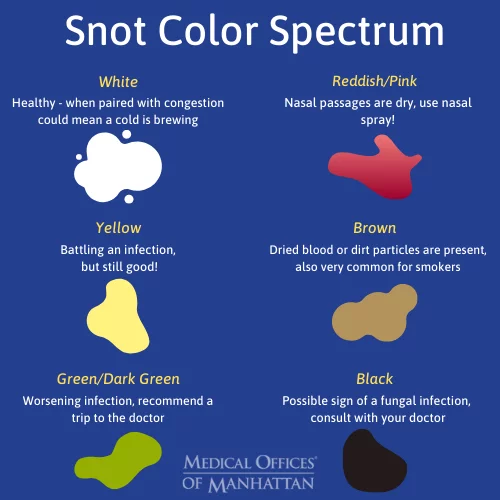
As we enter cold and allergy season, a lot of us are going to be feeling a lot more nasally blocked up than usual. It may be gross, but a little bit of congestion isn’t necessarily anything to worry about. However, depending on details including the severity of the blockage and the color of the mucus, it may be an indication that more serious factors are at play.
What is Mucus?
While typically we conflate mucus with what’s in our nose (snot, boogers, or whathaveyou), mucus exists throughout the body, coating organs and lining cavities. This viscous substance protects organs, assists with digestion, and prevents harmful particles from getting into parts of the body where they shouldn’t be. When we get sick, our body produces more mucus than normal to help fight off the illness, which is why our noses run when we come down with an illness.
Mucus Color and its Meaning
If you’ve been feeling unusually congested, noting what the tissue looks like after you blow your nose might help you make an educated guess as to why. The snot of a healthy person should be clear and relatively thin in consistency. Keep in mind that the color of your boogers should not be considered a clear indication of any root cause, but the following colors may offer some clues:
White
If you are feeling unusually congested with white mucus, it often indicates the early stages of a cold. This color results from an increased concentration of white blood cells, which fight infection.
Light Green or Yellow
Greenish or yellowish-colored snot signifies the presence of enzymes from white blood cells, meaning that your immune system is battling an infection. If you notice this color, you should make sure to hydrate and get enough rest to allow your body to recover.
Dark Green or Yellow
This color often indicates a worsening infection. If you notice dark green mucus, especially in conjunction with fever, coughing, and sneezing, you should contact a doctor to get your symptoms treated. It is particularly important to address this if you suffer from asthma.
Reddish
Red or pink coloration in snot comes from blood, which typically means that the nasal passage is dry or irritated. This is especially common in cold, dry weather. A nasal spray or dehumidifier may help with alleviating dryness.
Brown
Brown mucus could indicate the presence of dried blood, or dirt particles or residue resulting from smoking or pollution. Smoking cigarettes has a variety of negative effects on your respiratory and pulmonary health and we highly recommend seeking resources to help you quit.
Black
This is typically experienced by heavy smokers or people who live in highly polluted areas. In rare cases, black snot can be a sign of fungal infection. If you notice this color when you blow your nose, you should consult a doctor.
Remember that the color of mucus can be a broad indication of what is occurring in your body, but should not be considered sufficient for a diagnosis. However, if you are experiencing an unusually high amount of mucus production accompanied by other symptoms, you should consult a doctor.



